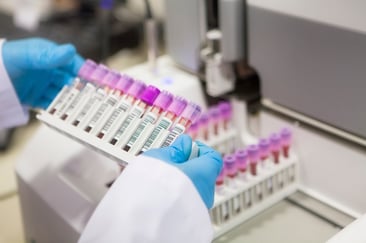 When you’re in charge of quality control (QC) for a clinical genomics testing laboratory, you know that one word — quality — casts a wide net. For you, quality means (among many other things):
When you’re in charge of quality control (QC) for a clinical genomics testing laboratory, you know that one word — quality — casts a wide net. For you, quality means (among many other things):
- Maintaining consistent and accurate test results, so clinicians can make informed decisions about their patient’s care.
- Decreasing turnaround time, so clinicians can make timely decisions about patient care.
- Reducing the need for retests, keeping your lab’s output as high as possible.
But through it all runs another concern that affects not only the wellbeing of your patients, but the sustainability of your business: cost. These days, lab budgets don’t leave much wiggle room. As part of your QC operations, you have to weigh the cost of every decision your lab makes.
When your lab buys a new piece of equipment, you think about cost. When your lab introduces a new procedure, you think about cost. When your lab suffers downtime, you think about the cost of lost productivity. And when you perform preventative maintenance, you think about the costs it will save you down the road.
How can you save money at your lab without sacrificing the other measures of quality, such as test accuracy and turnaround time?
In this article, we’ll look at three common cost drivers for clinical genomics lab and suggest strategies for reducing costs in those areas.
Cost Driver 1: Retests
Labs redo tests for two reasons:
- Factors within their control. Something goes wrong with performing the assay itself.
- Factors beyond their control. For example, insufficient DNA in the sample, an instrumentation problem, contamination, or a power outage.
But whatever the cause, every time your lab has to rerun the same test (labs have been known to redo tests seven or eight times when an assay keeps failing) it costs you money. On top of that, it prevents you from doing new tests, reducing your lab’s output. It can also cause your team to lose confidence in their results.
How to Reduce the Cost of Retests
Your most effective weapons in the war against retests are reliable controls. Controls prevent costly retests by helping you pinpoint exactly what causes tests to fail.
For example, if you’re running a batch of tests and the control works but all the samples fail, you’ll know the samples themselves were the problem. You won’t be forced to run the test again and hope for the best - you can simply take a closer look at the quality of the input sample.
What’s more, both the College of American Pathologists (CAP) and the Association for Molecular Pathology (AMP) recommend running controls as an essential element of test validation for NGS-based labs.
What kind of controls are most effective? Discover the nine characteristics of reliable reference materials in our recent whitepaper, “2 Tools For Overcoming Your Clinical Lab's Toughest Quality Control Challenges.”
Cost Driver 2: Downtime
Any NGS-based test comprises a complex series of steps involving human operators, reagents, and equipment. Whenever something goes wrong in one of these steps and your lab has to pause to search for the culprit, downtime strikes.
Downtime is a financial drag on clinical genomics labs; any time your lab is down is time you’re not making money. Plus, effective patient care requires timely results. Delays can hurt your lab’s reputation and prompt your customers to seek testing services elsewhere.
How to Reduce the Cost of Downtime
Again here, running controls is your best bet. With high-quality reference materials acting as a “truth set” for your lab, you will be able to ferret out problems and take action to correct them more quickly.
High-quality reference materials will also help you get new personnel up to speed quickly, reducing the amount of downtime spent on training.
Cost Driver 3: Mistakes
Nobody’s perfect, and lab teams are no exception. As in any other production process, mistakes happen in clinical genomics laboratories.
Mistakes can include mislabeling a sample, mis-typing a keyboard input, flipping the orientation of a 96-well plate, not filling a 96-well plate in the proper order...and the list goes on. Even if your lab has a 99 percent accuracy rate, that still means you’re sending out 10 incorrect results for every 1,000 samples processed.
When mistakes happen, they drive up expenses by:
- Causing delays as you amend reports and contact doctors (again, the dreaded downtime rears its ugly head).
- Forcing you to dedicate additional resources to reanalyze a patient sample — without being able to bill extra.
- In extreme cases, triggering costly and reputation-destroying litigation.
How to Reduce the Cost of Mistakes
Mistakes are inevitable, but you can significantly reduce both their frequency and severity by implementing a strong quality control management system. Your quality control management system should be proactive, not reactive. In other words, it should help you detect minor issues — wherever they occur within the complex NGS testing process — before they balloon into major problems.
Every step in the NGS testing process has a metric associated with it. If you track these metrics properly, as part of your QC system, you’ll be able to catch mistakes before they lead to higher costs.
To learn more about how to build a proactive quality control program that catches problems early, download your free whitepaper, “2 Tools For Overcoming Your Clinical Lab's Toughest Quality Control Challenges.”




